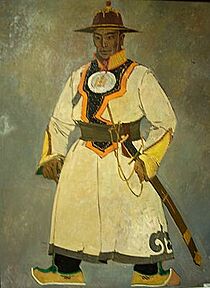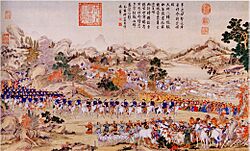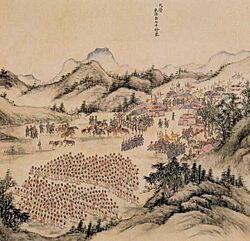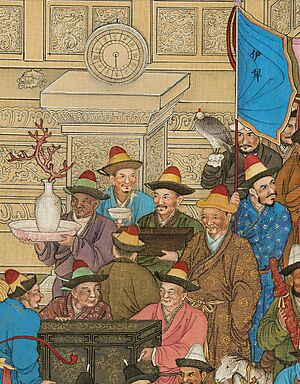Dzungar genocide facts for kids
Quick facts for kids Dzungar genocide |
|
|---|---|
| Part of the Conquest of Dzungaria | |
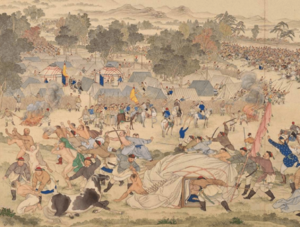
The Battle of Oroi-Jalatu (1756). Chinese general Zhao Hui attacked the Dzungar camp at night, in present Wusu, Xinjiang.
|
|
| Location | Dzungar Khanate (modern-day Dzungaria, Western Mongolia, Kazakhstan, northern Kyrgyzstan, southern Siberia, Xinjiang) |
| Date | 1755–1758 |
| Target | Dzungars |
|
Attack type
|
Genocide, mass murder, ethnic cleansing |
| Deaths | 420,000–480,000 (70%–80% of the Dzungar population, from both warfare and disease) |
|
Non-fatal injuries
|
Unknown |
| Perpetrators | Qing Manchu Eight Banners, Mongol Banners |
| Assailants | Qing Eight Banners, Khalkha Mongols, Kazakhs, Uyghur and Hui rebels |
The Dzungar genocide (Chinese: 準噶爾滅族; literally "extermination of the Dzungar tribe") was a terrible event where many Dzungar Mongol people were killed by the Qing dynasty. This happened after a Dzungar leader named Amursana rebelled in 1755. The Qing Emperor, Qianlong, ordered this to happen.
The Dzungars were a group of Mongol tribes who followed Tibetan Buddhism. They had formed a powerful empire in the early 1600s. Some historians believe that about 70% to 80% of the Dzungar people died. This was due to fighting and diseases during the Qing takeover between 1755 and 1757. After this, the Qing government moved other groups like the Han, Hui, Uyghur, and Sibe into the Dzungar lands.
Contents
Qing Takes Over Dzungaria
Why the War Started
The Qing dynasty fought against the Dzungars in a series of wars. The Dzungars lived in a large area. This area stretched from the western end of the Great Wall of China to parts of modern-day Kazakhstan, Kyrgyzstan, and southern Siberia. Much of this land is now in Xinjiang. The Dzungars were the last nomadic empire that posed a threat to China.
The Dzungars were skilled at making their own gunpowder weapons. They also had a mixed economy, combining farming and raising animals. They even had mining and manufacturing. They created laws to help people use the Oirat language.
After many battles, the Qing dynasty, led by the Manchu people, defeated the Dzungars in the late 1750s. The Qianlong Emperor first planned to divide the Dzungar lands into four parts. He wanted to make Amursana the leader of one part.
However, Amursana wanted to lead a united Dzungar nation. He refused the Qing's plan and rebelled. This made the Qianlong Emperor very angry. He then ordered that the entire Dzungar nation and its name be wiped out. Dzungar women and children were taken as slaves. Any remaining Dzungars were to be killed.
A Mongol prince named Chingünjav also rebelled against the Qing in 1756. His rebellion was quickly crushed. Chingünjav and his family were executed. The Qing Emperor then ordered his Manchu armies, called the Eight Banners, to conquer the Dzungars completely.
Orders to Destroy

The Qianlong Emperor gave very harsh orders. He said:
- "Show no mercy at all to these rebels."
- "Only the old and weak should be saved."
- He believed previous wars were too soft.
- He wanted his generals to "massacre these crafty Dzungars."
Historians believe that between 70% and 80% of the Dzungar people died. This was from disease and fighting between 1755 and 1758. Before the Qing conquest, there were about 600,000 Dzungars.
One scholar, Wei Yuan, wrote that about 40% died from smallpox. Another 20% ran away to Russia or Kazakh tribes. The remaining 30% were killed by the Manchu armies. Russian records also state that Dzungar men, women, and children were killed by the Manchu troops. The Dzungar lands remained empty for a long time.
The Emperor's actions are often called "ethnic genocide." He ordered the killing of most Dzungars. The rest were enslaved or sent away. The Encyclopedia of Genocide and Crimes Against Humanity says the Emperor's actions fit the definition of genocide.
The Emperor believed his orders were right. He saw the Dzungars as "barbarians" and less than human. He said that "sweeping away barbarians is the way to bring stability." He also believed that "Heaven supported the emperor" in their destruction.
Some of his commanders were slow to follow his orders. The Emperor repeated his command to "exterminate" them many times. Generals were punished if they didn't show enough effort in killing the rebels. Others were rewarded for taking part in the killings. The Emperor specifically told the Khalkha Mongols to "take the young and strong and massacre them." Older people, children, and women were spared but lost their identity.
Loyal Mongols and Manchu soldiers received Dzungar women, children, and old men as servants. Their Dzungar identity was erased. Historian Mark Levene calls this event "arguably the eighteenth century genocide par excellence."
Uyghurs Join the Qing
The Dzungars had previously taken over the Uyghur people. They made the Uyghurs pay heavy taxes.
Uyghur rebels from the Turfan and Hami areas decided to join the Qing. They asked the Qing for help to overthrow Dzungar rule. Uyghur leaders like Emin Khoja were given special titles by the Qing. These Uyghurs helped the Qing army fight against the Dzungars. The Qing told the Muslims from the Tarim Basin that they only wanted to kill the Dzungars. They promised to leave the Muslims alone if they helped.
The Qing even gave Dzungar people as slaves to the Turfani Turkic Muslims who supported Emin Khoja.
Changes in Population
The Qing's actions against the Dzungars left northern Xinjiang empty. The Qing then encouraged millions of Han Chinese, Hui, Uyghurs, and Manchu soldiers to move into Dzungaria. Today, the population in Xinjiang is similar to how it was after the Qing moved people in.
In northern Xinjiang, the Qing brought in many different groups. These included Han, Hui, Uyghur, Sibe, and Kazakh people. This was after the Dzungar Mongols were wiped out. During the Qing period, Xinjiang was mostly 62% Uyghurs in the south. About 30% were Han and Hui in the north. The rest were other smaller groups.
The Qing dynasty created Xinjiang as a unified region. They built new cities like Ürümqi and Yining in Dzungaria. After defeating another rebellion in the 1820s, the Qing moved 12,000 Uyghur families to Dzungaria. This was to help repopulate the area. The Dzungarian basin, once home to the Dzungars, is now mostly inhabited by Kazakhs.
Some historians believe that the Qing's victory helped Islam become more important in the region. This is because the Buddhist Dzungars were defeated. The Qing allowed and even supported Muslim culture. The Qing named the conquered Dzungar land "Xinjiang." They also turned a lot of grassland into farmland for new Chinese farmers.
Some people think the Qing's actions, like setting up farms, were meant to replace the Uyghurs. However, historian James A. Millward says that the Qing farms had nothing to do with Uyghur lands. The Qing actually stopped Han Chinese from settling in the Uyghur areas. Instead, they sent Han settlers to Dzungaria and the new city of Ürümqi. These areas had very few Uyghurs living there.
Qing's View of the Conquest
The Qianlong Emperor celebrated the Qing conquest of the Dzungars. He saw it as adding new land, Xinjiang, to "China." He believed China was a multi-ethnic state, not just for Han people. The Qing said that both Han and non-Han people were part of "China." This included the new land of "Xinjiang" taken from the Dzungars.
The Qing believed they were bringing all people, like the Mongols and Tibetans, together with the Han Chinese. They called this "one family" united under the Qing state. They used phrases like "interior and exterior as one family" to show this idea.
Under the Qing, people from Xinjiang were not allowed to be called foreigners. The Qianlong Emperor disagreed with earlier ideas that only Han people could be Chinese subjects. He said in 1755 that his dynasty's idea of China was different from older dynasties.
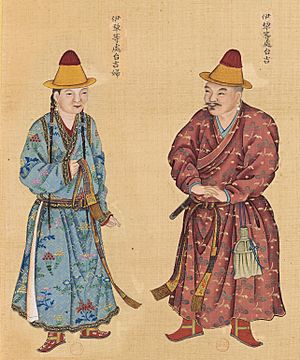
The Manchu Qianlong Emperor allowed Han people to move to Xinjiang. He also gave Chinese names to cities, replacing their Mongol names. He set up Chinese-style government systems. He encouraged Han migration to strengthen Qing control.
The Emperor and his officials also planned to promote Confucianism among Muslims in Xinjiang. They gave Confucian names to towns and cities. For example, Ürümqi was renamed "Dihua" in 1760.
The Qianlong Emperor compared his achievements to those of earlier Chinese dynasties, the Han and Tang. He wanted to restore the borders from those times. Qing scholars often referred to old Han and Tang names for the region. The Qing general who conquered Xinjiang, Zhao Hui, was compared to famous Han and Tang generals.
The Qing used ideas from both the Han and Tang ways of ruling Xinjiang. They also said their conquest was a continuation of Han and Tang achievements. Qing writers, even Manchus and Mongols, wrote about Xinjiang in Chinese. They used old Chinese place names and stories.


